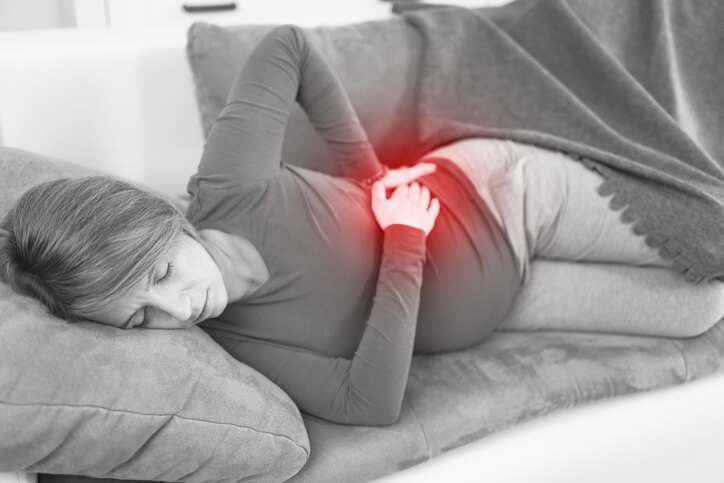Pregnancy brings about major changes to both your emotional and physical life, and feelings of excitement often coincide with feelings of anxiety and fear.
And this experience often comes with unexpected new symptoms that can have you questioning what’s a normal part of pregnancy and what isn’t.
One of these symptoms is pain in the right side of the body. And while this might feel scary, it’s most likely not a cause for concern.
Let’s look at the reasons for right side pain, how to alleviate it, and when to be concerned.
What Causes Right Side Pain During Pregnancy?
There are a few different reasons you might feel pain or discomfort on the right side of your body while pregnant.
Here are some of the most common.
Muscle Strain
Throughout the life cycle of your pregnancy, you’ll naturally start to put on some weight. Individuals gain an average of 25 to 35 pounds during pregnancy.
This weight gain is necessary to promote the development of a baby. However, it can also put a lot of strain on your muscles.
Not to mention, the pregnant body starts to release more of a hormone called relaxin, which makes the ligaments in the body more flexible.
This relaxation of the ligaments can make it easier to pull a muscle and lead to discomfort on one or both sides of the body.
A backache can spread to one side of the body, or you might pull a ligament from bending over to sleeping incorrectly.
Most muscle strains go away on their own, but you can alleviate some of the pain by using cold and warm therapies like ice packs or heating pads.
Stretch often, especially before or after exercising, to keep joints and muscles loose and prevent further injury.
Prenatal yoga can help you gain some muscular strength while loosening tightness on your body’s right side or left side.
Digestive Problems
Gas, bloating, constipation, and everything in between are common during pregnancy.
These are some of the more common reasons for right-side pain.
Hormonal changes during pregnancy can cause your intestines to digest food differently.
These are especially common in the first and third trimesters.
These hormonal changes can also lead to co-occurring digestive symptoms like heartburn or a sharp, shooting pain in the stomach or side of the stomach.
You can relieve some of these symptoms by eating plenty of fiber-rich foods and drinking plenty of fluids. Additionally, avoid dairy products, fried foods, and artificial sweeteners, as these are associated with gassiness.
Round Ligament Pain
The uterus must expand and grow to accommodate a baby.
The round ligaments are rope-like ligaments that hold your uterus in place. They get softer and stretch out as the uterus grows.
Softer ligaments are a good sign, but it might lead to feelings of discomfort in the lower right side, especially as these ligaments become irritated or tight. It might feel like a quick, sharp pain or a dull ache.
These sensations are worsened by quick, sudden movements like sneezing, coughing, or getting out of bed in the morning.
Round ligament pain worsens during the second trimester.
You can usually find relief by getting into a more comfortable position, but gentle stretches, moving more slowly, or flexing your hips can also help decrease the pelvic pain.
Cramping
Even though you’re not getting your period, you will likely experience pregnancy cramps from early pregnancy onward.
Cramps can feel like pulling or twinging on the right side or middle of your stomach and abdomen – just like menstrual cramps.
Cramping pain is most often caused by the growing uterus, but it can also be caused by sexual intercourse or a urinary tract infection.
Your healthcare provider can help define an appropriate treatment method based on why exactly your cramps are occurring.
However, you might be able to find some relief from meditation, breathwork, or yoga.
Braxton-Hicks Contractions
Braxton-Hicks contractions, also known as false labor pains or prodromal pains, are uterus contractions usually felt in the second or third trimester.
These are essentially the body’s way of preparing for true labor, but they don’t necessarily mean that preterm labor has already started.
These contractions feel like tightening or cramping in the lower stomach area and might feel like menstrual cramps. You might feel them on the right side, left side, the center of the abdomen, or all three.
So how can you tell the difference between these false contractions and real ones?
A real contraction starts at the top of the uterus and moves through the uterus to the lower segment. Braxton-Hicks only really feels like a tightening of the abdomen.
They’re also much more mild compared to real contractions.
Serious Causes of Right Side Pain
The common causes of right side pain listed above are not usually a cause for concern.
However, there are times when cramping or discomfort in your right side or lower abdomen might be a reason to contact your healthcare provider.
Ectopic Pregnancy
A fertilized egg implants itself into the uterine lining in a typical pregnancy. But in an ectopic pregnancy, the fertilized egg attaches and begins to grow outside of the uterus.
Ectopic pregnancies most often occur in the fallopian tubes, but they can affect other areas like the cervix or ovaries.
The pregnancy cannot continue if the egg attaches anywhere outside the uterus, as it can cause life-threatening complications.
The exact cause is unknown, but previous infections, smoking, or a history of fertility treatments are some common risk factors.
The early signs of an ectopic pregnancy are abdominal pain or discomfort. More often than not, the pain is on one side of the body.
This discomfort is often sporadic, but it can also be persistent. This symptom often combines with vaginal bleeding, nausea, and shoulder pain.
If you notice any of these symptoms co-occurring, you should see a doctor or OB-GYN (doctor of obstetrics and gynecology) immediately.
Miscarriage
A miscarriage is a loss of pregnancy before 20 weeks of pregnancy. Most miscarriages occur because the fetus is not developing as expected, and while it’s relatively common, it doesn’t make it any easier.
Symptoms of a miscarriage can include lower back pain or cramping in the abdomen, but it’s often coupled with symptoms like vaginal bleeding or fluid passing from the vagina.
If you notice these symptoms, contact a doctor right away. And if you pass tissue from the vagina, place it in a container and bring it to a hospital for analysis.
Miscarriages are not due to exercise, sexual activity, or working. Again, they often occur as a result of the fetus developing improperly. They are most likely to happen in the first trimester.
Preeclampsia
Preeclampsia is a pregnancy complication in which you might experience high blood pressure, high levels of protein in the urine, or other signs of possible organ damage.
Preeclampsia can lead to serious or fatal complications for both the mother and baby if left untreated.
Preeclampsia is associated with several symptoms like severe headaches or shortness of breath.
However, it can also present as stomach pain in the upper abdomen, specifically under the ribs on the right side of the body.
There are two options for treating preeclampsia. The first is to deliver the baby if it’s close enough to the due date.
The other is to manage the symptoms until there’s a better time to deliver the baby. Treatments include antihypertensive drugs to lower blood pressure and corticosteroids to promote the development of the baby’s lungs.
In Conclusion
Pain on the right side of the body during pregnancy can be scary, but it’s not something to be concerned about in most cases.
Braxton Hicks contractions, muscle strain, digestive problems, round ligament pain, and cramping are all expected pregnancy symptoms that do not typically warrant concern.
However, there are times when pain on the right side can be a bit more severe, such as with a miscarriage, ectopic pregnancy, or preeclampsia.
In general, if you notice multiple severe symptoms or bleeding from the vagina while pregnant, you should contact a medical professional just to be safe.
References, Studies and Sources:
Relaxin in Human Pregnancy | PMC
Round Ligament Pain: What Does It Feel Like, Causes & Treatment | Cleveland Clinic
Braxton Hicks Contractions – StatPearls | NCBI Bookshelf
Preeclampsia – Diagnosis and treatment | The Mayo Clinic

Bridget Reed is a Tampa-based content development manager, writer, and editor at GR0; specializing in content related to varying fields including medicine, health, and small businesses. Bridget went to St. Petersburg College and majored in Management and Organizational Leadership.
Recent Publications: Body Acne 101: Prevention and Treatment, Stress Acne: Causes, Prevention, and Treatment, What are the Side Effects of Midol?

